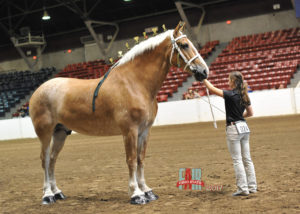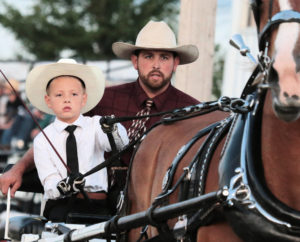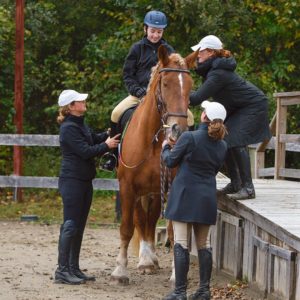The Belgian Draft Horse Alliance, Inc. has established guidelines to help you become a more accomplished horseperson. Guidelines cover the
following topics:
- Showmanship (preparation, exhibiting)
- Decorating (grooming, braiding)
- Single and Team Driving (preparation, exhibiting)
- Judging (following, inspection)
Note: Judges, show committees and parents are also encouraged to follow these guidelines.
This information is also in pdf form.
YOUTH GUIDELINES
Showmanship
Purpose
The purpose of youth showmanship is to present the horse to the judge in the most positive manner.
Preparation of the Animal
Cleaning: The animal should be bathed and groomed before entering the ring.
Clipping: Head in general, long hairs on the face, around the eyes, ears and bridle path. Shorten and even up the mane hair as needed.
Optional Clipping: Underneath pasterns to open fetlock area and improve appearance of pastern. Also, any long belly hair that distracts from the confirmation. Bridle or Halter: Should fit properly and be cleaned and polished with appropriate lead shank.
Hooves: Finished neatly, generally with a black or clear polish.
Tail: Braided and tied.
Mane: Rolled when appropriate.
Preparation of Exhibitor
- Select and practice with animal prior to entering the show ring.
- Dress neatly.
- Have exhibitor number clearly visible.
- Have show stick and understand its use.
Exhibiting
- Exhibitor should have lead strap in right hand and short show stick in left. When moving with the horse, its head should be even with your right shoulder. If you are out ahead pulling the animal the head will come down and the horse will won’t be able to travel freely. If you are too far behind the horse you may loose control. Horse and exhibitor should travel together.
- Enter the ring at a controlled trot, horse’s head up.
- After entering the ring, park on rail at the direction of the judge or ring steward. After stopping at the rail, turn yourself 180 degrees so that your left shoulder is next to the horse. Change the lead to the left hand and show stick to the right hand. When setting up and showing horse, lead should always be in left hand. When moving horse at walk or trot, lead should be in right hand.
- Exhibitor should wait their turn for judge to call or motion them to present horse. When directed, lead horse to judge and get instructions for presenting horse, if it has not been done by the ring steward earlier. Instructions might be: “Walk a few steps and trot further, turn around, walk a few steps and return at a trot with your horse.” You will line yourself up in front of the judge and go directly away as directed. While leading away from the judge the exhibitor must prepare for the return and should do as the diagram suggests. The horse should be led to the left of the line of travel, turn to the right back into the line of travel, returning directly to the judge who should not have to move to see the horse travel. Exhibitor should be watching the horse and follow the line of travel. In preparing to set the horse up for final inspection, the exhibitor should stop the horse a safe distance from the judge. In setting up the horse, the front feet should be set squarely under the shoulders and the back feet should be together or one slightly ahead of the other if they cannot be kept even. The horse should be kept clean. Exhibitor attention should be closely divided between the horse and the position of the judge as the inspection is completed. As the judge inspects the horse, the exhibitor should not obstruct their view. When the judge has completed inspecting the horse, the exhibitor should turn the horse to the right and trot smartly away from the judge unless otherwise instructed.
- Upon returning to the rail, the horse should be set up in line and presented in anticipation that the judge could be looking at any time. However, both the exhibitor and the horse are allowed a more relaxed position.
- During the final inspection on the rail, the judge may ask you to move the horse from the line t0 be placed in a new position. When doing so, the horse should be backed from the line, turned to the right, and led to the assigned position.
- Remember, keep showing your horse until the class is over. The judge may still switch the horse around until he or she writes the numbers on the score card. The judges should make every attempt to speak with each exhibitor before they leave the ring.
- Always be a gracious winner and a good sport, no matter where you placed.
Decorating
Participants must enter the ring with a horse that is clean and groomed. Braiding bench, braiding decorations and all braiding equipment should be provided by the participant. An assistant may be used to hold the horse. Participants will be required to complete the minimum requirements.
- A seven flower hitch braid.
- Tie the tail. The knot should be tight, neat and in the center of the tail.
- All decorations should be complete within a 30 minute time limit.
- Final placings will be determined by the mane and tail decorations. the overall appearance or the horse and your performance throughout the class.
- The judge should make every attempt to speak with each exhibitor before they leave the ring.
- Always be a gracious winner and a good sport no matter where you place.
Single & Team Driving
Purpose
Youth drivers or a single or team are entering this class to gain experience.
Preparation
Practice: The youth should gain experience driving at a walk, trot, back and other maneuvers generally used with draft horses.
Horses: The horse(s) are to be judged on their performance with and suitability for the youth driver. The horse(s) must be clean, groomed, and presented in the most positive manner (horses are not judged for conformation in this class).
Harness: Harness must be safe, clean, and properly adjusted.
Vehicle: A cart or wagon which is clean, safe and in good repair.
Attire: Youth must dress in clean, appropriate clothing and carry a whip.
Posture: The driver must be straight in the back, sit back in the seat, the feet reaching to a foot rest with the elbows slightly forward of the body.
Position: The driver is usually seated on the right to access the brake at all times and is generally accompanied by an experienced driver.
Final Preparation:
- The driver must check the hitch for appropriate adjustments for safe driving.
- The driver must achieve appropriate tension on the lines and have the whip in hand.
- The driver should know the location of the judge and the ring steward.
Exhibiting:
When the unit enters the ring the driver will be evaluated throughout the class on their posture, use of hands to gather and adjust lines and use and position of arms and legs. The driver’s arms should be forward of the body while the horses work as a smooth consistent unit. Drivers will be evaluated on their ability to command horses along the rail at a walk and trot, to reverse direction, to line up, to stop, to stand, and to back. A figure eight or swing may be requested at the discretion of the judge. Other maneuvers should not be expected in youth classes.
- Enter the ring with the unit bearing to the right at a safe speed.
- When all units are in the ring. you should space yourself and follow the directions or the ring steward. Use of a whip may be necessary. Correct
posture should be maintained at all times. - Upon direction you will bring your horses to a smooth walk.
- Upon completion of the walk the drivers will be asked to make a smooth transition to a trot.
- At the direction of the ring steward, the driver will reverse direction on the diagonal assuming an inside path until the rail is clear.
- After all units have reversed, a trot on the rail will be continued. Another walk may be requested before leaving the rail.
- Upon direction the units will be asked to line up in the center of the ring. This should be executed with a smooth and controlled stop.
- After stopping. the horses should stand quietly. The driver may relax the lines but must hold them in anticipation or starting, whip in hand. A header is optional but the experienced driver must remain on the wagon.
- The judge will complete an inspection of the hitch. When asked to back, the driver should use the lines to signal the team to move backward in unison, complete the back, stop and move forward. The driver should use planned signals throughout this process.
- When placed, the driver should leave the ring driving in the same fashion as when entering the ring.
- The judge should make every attempt to speak with each exhibitor before they leave the ring.
- Always be a gracious winner and a good sport no matter where you place.
Judging
You are judging every time you so much as glance at a horse. Each time you look you will have thoughts about things you see that you may or may not like about the horse. You may like its color, the way it stands, its size, or you may wish it was groomed differently. However, at some point you formulate your thoughts and determine which you like best. You must know the parts of a horse and learn to use the terms. You are putting your knowledge and skill to use each time a judgement has been made. You will be asked to place each individual in the class in order of overall quality. Your placings will be compared to those of an official judge. Questions may be asked and/or oral reasons may be given on or about horses in each class. A typical class for a judging contest will consist of four animals. When judging you will be asked to compare each individual animal in a class with the other individual animals in the class and place each in the the order of your preference.
Judge every horse you see to practice and develop confidence in yourself and your ability to recognize types of horses, their condition, and how well they handle themselves.
Judging Procedure:
When judging, you should look for the most ideal individuals today, in terms of soundness, conformation, correctness, quality, fitness, correct way of moving, and the potential to improve the breed.
A definite method of judging a horse should be used to help you avoid overlooking any problems with the horse. The following is a common method:
- Stay in a position to get a long-range view of the horse. You are developing an opinion of overall appearance.
- Watch the horse move. When watching the way of going you will try to get directly in line with the direction the horse is moving to get a view of foot and leg movement at a walk and a trot. Watch for lameness, crampiness and stringhalt.
Study the knee action both at the walk and trot. The front feet should break over straight with no wing or paddle. Pay special attention to hock action.
The horse should go close behind with a lot of flex to the hock. A high going horse that can move correctly, with its head naturally in the air is ideal. - Once the horse is stood for inspection. you may be allowed to move in closer. Always move quietly and steadily as you get in its space.
- Start at the from of the horse. Check the eyes for blindness. Look at or feel the teeth for overbite or underbite. Look at the head. It should have breed character. Masculine if it is male and feminine if it is a female. It should be sharp looking with an attractive ear and eye. Step in front or the horse. It should stand with its front feet placed squarely. Check for splints, although in most cases they are not considered an unsoundness in a draft horse unless they are too close to the knee. The hoof head should be large and well shaped. Check for unsoundness at the hoof heads such as side bone and/or ring bone.
- Move to the near side. The front legs should be straight, not bowed back (calf kneed) or rocked forward (buck kneed). The forearm should have a lot of width and muscling, the cannon bone should be long. The rear legs should be set correct not too straight in the hocks or not sickle hocked. Look for length of neck, sharpness at the withers and a sloping shoulder. Note the balance of the horse: heart girth deep, well-ribbed middle, medium slope to the croup and a strong back. Study the underpinning. Note the amount and quality of the bone. The pastern should be long, sloping and neat in the ankle. Observe the inside of the hock for unsoundness.
- Move to a position in the rear. Remain at a safe distance. The hocks and lower legs should be close. The hocks should be free from unsoundness (i.e. curbs, spavins, thoroughpins, and windpuffs). The hock itself should be smooth and blend well into the cannon bone. The cannon bone should be flat and have width. Note the width or heels front and rear. The breeching should be well muscled. Always check stallions for two normal size testicles.
- Move to the off side. Repeat the same procedure as on the near side.